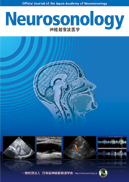巻号一覧

32 巻 (2019)
- 3 号 p. 121-
- 2 号 p. 43-
- 1 号 p. 1-
32 巻, 3 号
選択された号の論文の4件中1~4を表示しています
- |<
- <
- 1
- >
- >|
目で見る神経超音波診断
-
山下 ひとみ, 平野 照之2019 年 32 巻 3 号 p. 121-123
発行日: 2019年
公開日: 2020/01/25
ジャーナル フリーPDF形式でダウンロード (1223K)
原著論文
-
貞廣 浩和, 杉本 至健, 石原 秀行, 岡 史朗, 鈴木 倫保2019 年 32 巻 3 号 p. 124-128
発行日: 2019年
公開日: 2020/01/25
ジャーナル フリーIncreases in flow velocity are observed with duplex ultrasonography when carotid artery is highly stenotic. It is very common that NASCET of 70% stenosis often shows peak systolic velocity (PSV) of over 200cm/s. The higher the stenosis, the more PSV increases. However, if the artery is occluded, the velocity cannot be detected. Therefor there should be turning point in flow velocity. There are no previous studies which mention the turning point with actual patients. Sixteen patients who underwent staged carotid artery stenting (CAS) were included to investigate the change of flow velocity using duplex ultrasonography between pre-operation and post percutaneous transluminal angioplasty (PTA). After PTA, all patients showed improvement of their stenosis significantly (84.4 ± 7.3% vs. 64.1 ± 17.2%, p < 0.001). While 8 patients PSV decreased, the other 8 patients PSV increased. In 6 patients who had PSV < 350cm/s with high stenosis, all patients showed increasing PSV after PTA. This study demonstrated that the flow velocity observed with duplex ultrasonography could increase when high stenosis mildly improved, especially in patient with pre-operative PSV < 350cm/s.抄録全体を表示PDF形式でダウンロード (402K)
症例報告
-
榛沢 和彦, 伊倉 真衣子, 森下 篤, 西松 輝高, 赤尾 法彦2019 年 32 巻 3 号 p. 129-133
発行日: 2019年
公開日: 2020/01/25
ジャーナル フリーA 21-year-old Indonesian woman came to hospital with severe headache and vomiting. Brain MRI showed multiple subcortical lesions. High-intensity transient signals (HITS) was detected in the carotid artery and transesophageal echocardiography (TEE) was performed to search for embolic sources. Mobile string-like structures were found in the aortic arch. We started anticoagulation therapy. One month later, TEE reexamination revealed that the aortic arch cord had shrunk, but numerous cords were found in the pulmonary artery. She was suspected with Angiostrongylus cantonensis infection and treated with antiparasitic agent and steroids. One month later, the TEE was performed again, and the cord-like structure in the aortic arch almost disappeared, and the abnormal structure in the pulmonary artery also disappeared. It is known that A. cantonensis can cause eosinophilic meningoencephalitis, but its prognosis is good, and it is thought that it may be mild. In this case, although the definitive diagnosis has not been made, the possibility was considered to be high because antiparasitic agent was effective. HITS detection for investigating the cause of multiple subcortical lesions was considered to be useful in determining the embolic mechanism.抄録全体を表示PDF形式でダウンロード (1134K)
技術報告
-
萩原 悠太, 飯島 直樹, 小倉 英, 清水 高弘, 長谷川 泰弘2019 年 32 巻 3 号 p. 134-138
発行日: 2019年
公開日: 2020/01/25
ジャーナル フリーTransoral carotid ultrasonography (TOCU) is a powerful tool for evaluating internal carotid artery lesions located from the carotid bifurcation to the second cervical vertebra. In recent case reports, contrast-enhanced transoral carotid ultrasonography (CETOCU) and superb micro-vascular imaging (SMI) which are useful in endovascular therapy are emerging. Lately, three-dimensional (3D) and four-dimensional (4D) ultrasound have been widely used in angiology. We developed 3D-TOCU and used it in a healthy man to confirm the utility of the 3D technique. Mutual conversion to the long axis from the short axis is possible based on an image of a vessel using multiplanar reconstruction (MPR) in 3D-TOCU. By operating the ultrasound machine, a novice examiner can obtain an adequate image in TOCU. TOCU performed with single sweep mode can produce the intraluminal vessel image from proximal to distal on the short axis, which is not possible with conventional TOCU. 3D-TOCU is expected to be clinically useful.抄録全体を表示PDF形式でダウンロード (706K)
- |<
- <
- 1
- >
- >|